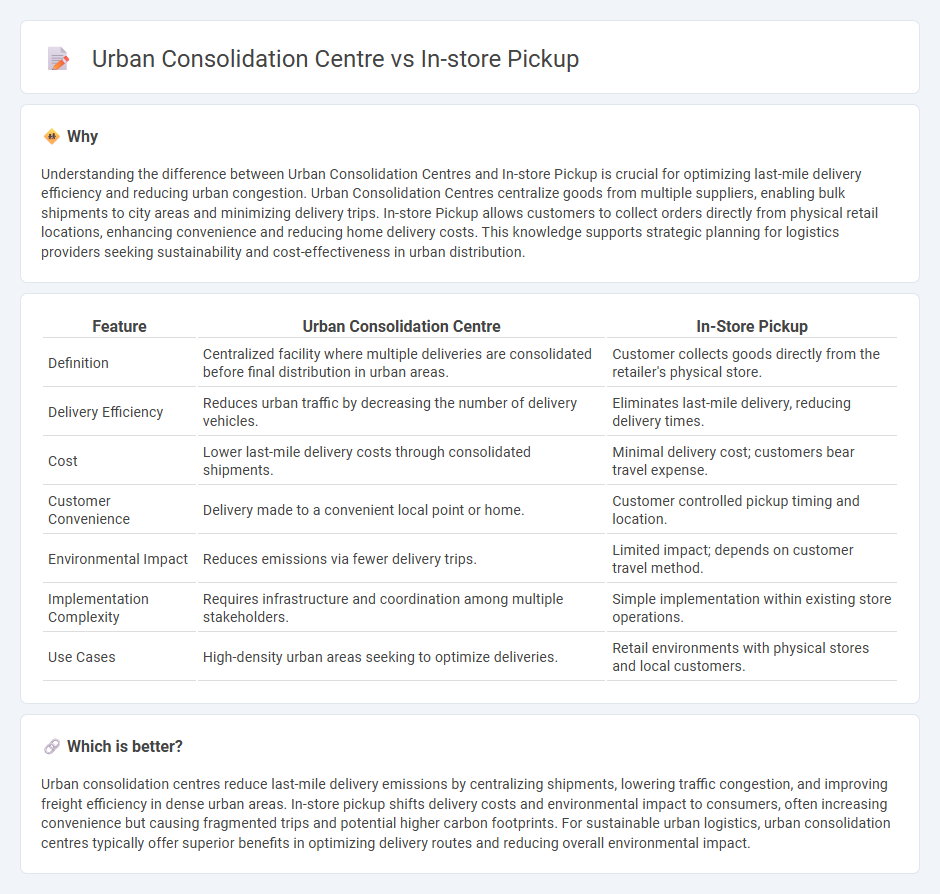
Urban consolidation centres streamline last-mile delivery by centralizing shipments, reducing traffic congestion, and lowering emissions in crowded city areas. In-store pickup offers convenience and cost savings by allowing customers to collect purchases directly without waiting for home delivery. Discover how these logistics solutions enhance urban supply chains and improve customer experience.
Why it is important
Understanding the difference between Urban Consolidation Centres and In-store Pickup is crucial for optimizing last-mile delivery efficiency and reducing urban congestion. Urban Consolidation Centres centralize goods from multiple suppliers, enabling bulk shipments to city areas and minimizing delivery trips. In-store Pickup allows customers to collect orders directly from physical retail locations, enhancing convenience and reducing home delivery costs. This knowledge supports strategic planning for logistics providers seeking sustainability and cost-effectiveness in urban distribution.
Comparison Table
| Feature | Urban Consolidation Centre | In-Store Pickup |
|---|---|---|
| Definition | Centralized facility where multiple deliveries are consolidated before final distribution in urban areas. | Customer collects goods directly from the retailer's physical store. |
| Delivery Efficiency | Reduces urban traffic by decreasing the number of delivery vehicles. | Eliminates last-mile delivery, reducing delivery times. |
| Cost | Lower last-mile delivery costs through consolidated shipments. | Minimal delivery cost; customers bear travel expense. |
| Customer Convenience | Delivery made to a convenient local point or home. | Customer controlled pickup timing and location. |
| Environmental Impact | Reduces emissions via fewer delivery trips. | Limited impact; depends on customer travel method. |
| Implementation Complexity | Requires infrastructure and coordination among multiple stakeholders. | Simple implementation within existing store operations. |
| Use Cases | High-density urban areas seeking to optimize deliveries. | Retail environments with physical stores and local customers. |
Which is better?
Urban consolidation centres reduce last-mile delivery emissions by centralizing shipments, lowering traffic congestion, and improving freight efficiency in dense urban areas. In-store pickup shifts delivery costs and environmental impact to consumers, often increasing convenience but causing fragmented trips and potential higher carbon footprints. For sustainable urban logistics, urban consolidation centres typically offer superior benefits in optimizing delivery routes and reducing overall environmental impact.
Connection
Urban consolidation centres reduce delivery distances and congestion by aggregating shipments, making last-mile logistics more efficient and environmentally friendly. In-store pickup leverages these centres by allowing consolidated deliveries to retail locations, where customers collect their orders, minimizing failed deliveries and returns. This synergy enhances urban logistics by optimizing transport routes and improving customer convenience in dense metropolitan areas.
Key Terms
Last-mile delivery
In-store pickup offers immediate customer convenience by allowing shoppers to collect orders directly from retail locations, reducing delivery time and mitigating last-mile delivery challenges in urban areas. Urban consolidation centres optimize logistics by consolidating parcels for multiple retailers, decreasing traffic congestion, emissions, and delivery costs through centralized distribution hubs. Explore deeper insights on how these strategies transform last-mile delivery efficiency and sustainability.
Order fulfillment
In-store pickup streamlines order fulfillment by allowing customers to collect purchases directly from retail locations, reducing last-mile delivery costs and enhancing convenience. Urban consolidation centres optimize order fulfillment through centralized sorting and aggregation of goods, decreasing delivery trips and emissions in congested city areas. Explore the benefits of these order fulfillment strategies for efficient retail logistics.
Inventory management
In-store pickup streamlines inventory management by allowing retailers to directly allocate stock from physical stores, ensuring real-time accuracy and reducing overstock risks. Urban consolidation centres centralize inventory from multiple suppliers, optimizing stock levels and minimizing distribution complexity across urban areas. Explore how these models enhance operational efficiency and customer satisfaction in retail logistics.
Source and External Links
Kohl's In-Store Pickup - Customers buy products online and collect them from a local Kohl's store, offering convenience and saving time by selecting in-store pick up during checkout, then retrieving their order upon email confirmation.
JCPenney Same Day In-Store Pickup - Orders placed online 2 hours before store close can be ready within 2 hours for free same day pickup; customers present ID and order confirmation in-store or use curbside pickup options during store hours.
Walgreens Order Pickup - Curbside, Drive-Thru & In-Store - Online shoppers can pick up orders in as little as 30 minutes choosing curbside, drive-thru, or in-store pickup at the photo counter, receiving notifications by email or text once orders are ready for pickup.
 dowidth.com
dowidth.com